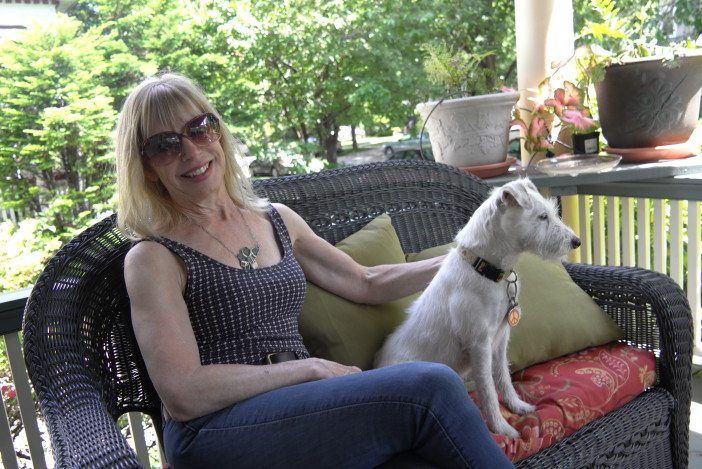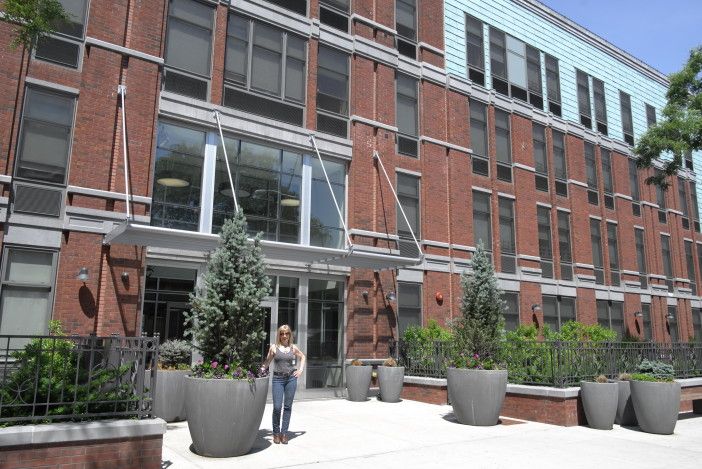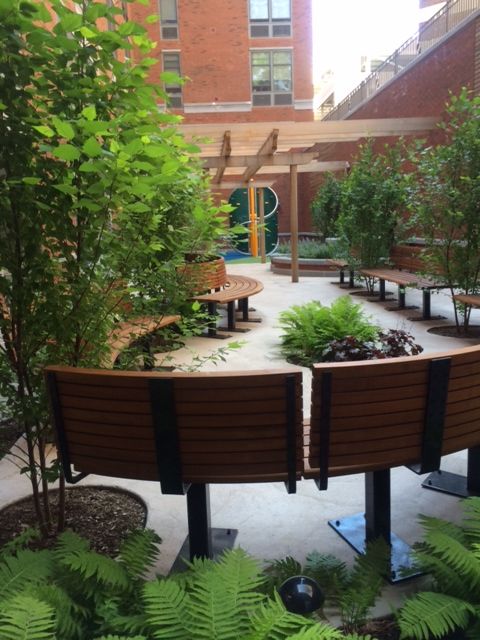The Ditmas Park Word: Cindy Harden On Affordable Housing, Our Neighborhood’s Growth & More

From new transplants hailing from places across the city, country and globe to residents who have lived in our area for decades, our neighborhood is home to an amazingly diverse collection of people. This interview is part of our “The Ditmas Park Word” series, in which we’ll get to know some of our wonderful neighbors who make our community what it is today. For our latest addition, we interviewed Cindy Harden, an architect who has lived in the neighborhood for close to a quarter of a century.
How long have you lived in the neighborhood? We moved here 24 years ago. I live here with my husband, Donald Bussolini, our son Chris who is now in college, and our dog Wilson.
Where did you live prior to living here? We lived in Sunset Park for six years but I’m originally from Vinings, Georgia.
What prompted the move to this neighborhood? We had looked here at one time but could not afford it at that time. I wanted to live here; it is like a secret neighborhood. When I was a girl in Georgia I enjoyed spending time at my grandmother’s house on the front porch, so I always wanted to live in a house with a front porch. In 1991, we decided to look again and found this house on East 17th Street, between Ditmas & Dorchester.
What kinds of changes have you seen in the neighborhood over the past 24 years? There have been some very positive changes. There are more dining options, and the shopping has improved. When we moved here the only place was San Remo. Then, a restaurant opened in the space that would later become Picket Fence (now Asya), and you ran into all of your neighbors there. In addition, the food shopping has improved with the new Key Food and the expanded Flatbush Food Coop.
In the past eight to 10 years, more families with young children have moved to the neighborhood, and this was not the case when we moved here. I have noticed that people are getting more creative with their landscaping and changing out the traditional boxwood bushes, which can look outdated and, in many cases, have not been pruned correctly over the years. It makes the neighborhood more interesting with different types of plantings. The downside of some of these positive changes is that people are being priced out of the neighborhood.
What do you like about the neighborhood? We enjoy the physical beauty of it, the openness and the light. Every few years there is an article about Ditmas Park “being discovered,” which I find ironic. We also enjoy the diversity here. Our son went to the local school P.S. 217, and he had a great academic education but also learned a lot from the diverse student body.
What is missing in our neighborhood? I would like to see more development on the side of Cortelyou Road that is closer to Ditmas Park proper. I have heard talk that more bike lanes will be added and that would be nice. Ditmas Park itself has landmark designation but some of the surrounding neighborhoods are not landmarked, and that is unfortunate because there are buildings being built that are inappropriate. It is interesting to contemplate what those neighborhoods would be like today without the larger buildings that have been put up. So, I hope the city will landmark these other neighborhoods to preserve and protect these houses.
Finish this sentence: Ditmas Park is… unique in New York City.
Do you have a favorite store in the neighborhood? The wine store!
Do you have a favorite restaurant in the neighborhood? I really like The Castello Plan; they have great small plates.
[pullquote]When you live next to someone who has different beliefs than you, it makes you a more open, compassionate and loving person.[/pullquote]
We live in a very diverse neighborhood; how meaningful is that to you? It means a lot to me because I came from the South, and the population was not diverse at all. My parents were liberal but I grew up with strong religious beliefs which perhaps made me close-minded. But now I have come to respect everyone’s beliefs. When you live next to someone who has different beliefs than you, it makes you a more open, compassionate and loving person.
What do you think of Brooklyn’s newfound popularity? It is humorous, and it’s great. I still have a hard time convincing some people I went to high school with to visit Brooklyn, but I found that Europeans in particular want to visit. It is always a double-edged sword; you want the restaurants, and you want your property values to increase, but then you are in danger of losing what made the neighborhood special — which is the diversity. We are on the cusp of that happening, and I hope we can keep it in balance. It is the age old question of urban planning. How do you keep a community vibrant, but not drive other people out who can no longer afford to live there?
What is your profession? I’m an architect and I own my own business, Harden + Van Arnam Architects.
Where did you study? I did my undergraduate work at Georgia Tech and then spent a year in Paris at École Des Beaux-Arts. I went to graduate school at Washington University in St. Louis, where I studied architecture and social work because I wanted to focus on community-related architecture.
Where did you work before you founded your own business? I worked at Pratt Institute, where I ran the Pratt Architecture Collaborative, a non-profit community design center providing free and/or low-cost architectural planning to non-profits and neighborhood groups.
When was your firm founded and what types of buildings to you specialize in? We were founded in 1989 and 95 percent of the work we design is affordable and supportive community housing. Aside from apartments, supportive housing can include: computer rooms, daycare, teaching kitchens, fitness and recreation rooms, community rooms and social services. The designs vary depending on the residents who will be living there.
[pullquote]When I was a teenager, I knew I wanted to be an architect, and it occurred to me that living in a beautiful place can improve your life and give you a sense of dignity.[/pullquote]
Why did you want to specialize in affordable housing? When I was growing up, I lived in a beautiful house in a beautiful setting that my grandfather built. When I was a teenager, I knew I wanted to be an architect, and it occurred to me that living in a beautiful place can improve your life and give you a sense of dignity.
What populations do your buildings serve? The buildings house the formerly homeless and people coming out of the shelter system, women and children coming out of domestic violence situations, people with a history of mental illness and people who have had substance abuse issues in the past who are in need of support. We have also built buildings that serve young people aging out of foster care and homeless veterans. There are also organizations that create housing for people who were formerly incarcerated.
How do you create affordable housing that is also attractive? It is complicated and takes a lot of dedication and knowledge so having 30 years of experience helps. We spend a lot of time selecting materials and finishes that are affordable yet still beautiful. The initial plan is to always build the best building we can, and if we have to cut corners for budget reasons, we still find ways to build the best building anyway. We like to include large windows in our buildings to let a lot of light in and articulate the facades to make them more attractive. We surround the buildings with beautiful landscaping, sometimes garden plots, and passive and active outdoor spaces.
How do you create “green” buildings? There are many ways we do this. We use an exterior wall system that is highly insulated. We bring constant fresh air into the building. We use windows with Low-E glass that reduce the amount of solar gain into the building and a green or white roof to reflect the light, which results in less of a need for air-conditioning. We employ solar panels to supply energy, and we provide as much natural light as possible to reduce the need for artificial lighting. We use recycled materials and materials which are manufactured within 500 miles which reduces the energy needed to transport the materials. The buildings are equipped with Energy Star appliances and efficient lighting, that is controls for lighting in corridors that are not on all the time — only when someone is walking through them. We use drought tolerant planting to save water.
What types of challenges do you face in building this type of housing? It is challenging because the funding for these types of buildings usually comes from multiple sources — state, city, federal — and they all have their separate requirements. There are also the many regulations imposed by the NYC Department of Buildings that one has to navigate.
What is the community response to these buildings? Often there is opposition at first, but we design beautiful, buildings to try to overcome it. And most often our building will wind up being the most beautiful one on the block and improve the neighborhood. Then the community sees that whatever fears they may have had, that their property values will go down, are not realized.

Tell us about your project Camba Gardens in Flatbush. We created a living wall of plants in the lobby. There is also a green roof with a variety of plantings and benches and the building is surrounded by lush landscaping. For the use of the residents the building also contains a computer room, spaces dedicated to social services, a teaching kitchen, a large multi-purpose room and outside there is a dedicated space where residents can grow their own vegetables. These buildings received the LEED Platinum certification (the highest level), which means that they are highly energy efficient, sustainable and healthy.

How does living in a nice environment affect the residents? If you give people a building that shows you respect them, you will give them a sense of dignity and they will treat their home with respect and take care of it. It is a simple concept.
Do you have a dream project? I would like to consider working on projects in an impoverished country like Nepal, which I visited in 2013 (and am returning to this fall). The poverty there is mind-boggling. If someone has an indoor toilet they are considered rich. When visiting a place like Nepal you get a real perspective of what we take for granted. You learn what people really need to live with dignity, and as it turns out the answer is not much.




